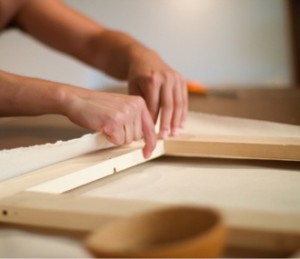Why do Artists' use stretched canvas?
Author: Tom Date Posted:2 September 2016

It’s been a while between posts lately! I have been brainstorming some ideas for blog posts and would love your input, please email me customerservice@artshedonline.com.au anytime!
One question we get asked frequently in our store, and something that is fundamental to understand when painting, are the differences between types of canvas available in the Art Supplies market.
Put simply canvas is a material not unlike many fabrics used in the production of clothing and textiles which is primed, or prepared to allow the surface to become ideal as a support for painting. Canvas is most commonly stretched over timber stretcher or strainer bars, giving the painter a flexible and forgiving painting surface.

Many historians cite the Renaissance as the point where Artists began to choose canvas for painting supports, as they moved away from painting on wood and plaster walls to create portable outdoor displays for festivals and parades. Painting onto stretched materials and fabrics offered those Artists a range of benefits including durability and portability as they could stretch and remove from stretchers to carry around finished paintings.
It is worth considering that for a long time stretched canvases were a real luxury and they have only become more affordable in recent years. Prior to the availability of canvas Artists often used timber, Masonite or even cardboard as a painting support – some still elect to use these materials, however, some of these lacked the archival quality and flexibility of stretched canvas and restorers at places like the National Galleries have plenty of work because of this, there are some stories of paintings disintegrating on the gallery walls; one such Artist was Toulouse Lautrec who did many paintings on cardboard.
So the reason many Artists choose to use stretched canvases in recent years is partly due to wider availability as mass manufacturing has improved dramatically and imported stretched canvases are now to the standard of a canvas you could get stretched locally. Generally stretcher bars are made using a timber such as pine which is dried out multiple times in large kilns to reduce the likelihood of the timber bowing.
While canvas is a very stable surface to paint on - as the weave of the cotton or linen has the ability to move and stretch as necessary when the paint is active on the surface; it is worth keeping in mind that in choosing a wooden supported painting surface, you may sometimes experience slight warping or find your canvas has gone out of square. This can be caused by a range of factors – including the climate of the space you store you canvases – you want a nice steady climate, preferably not too humid. This can also be caused by undue weight put on the stretcher frame when it is leaning against a wall for example.
I will leave you with these tips!
If you are charging top dollar for your artwork, or it is a commission – don’t skimp on the quality of canvas you use. You don’t want to use a lighter weight canvas or lower grade stretcher.
You can tell the quality of a canvas by looking at the back of it. If the cotton is a cream colour with little speckles through it you are looking at an unbleached and fairly heavy cotton which is suitable for most painters.
If you are at all worried about bowing of your stretcher frame, particularly for larger size, make sure you store your canvas in a room with a steady climate. Wood which is use for stretchers is a natural material and while it has been dried, it is inevitably always going to be active – if you want to avoid this altogether, I would recommend sourcing an aluminium support frame instead.
Comments (2)
When to put in wooden wedges? Before or after pain
By: Maurice Thorne on 20 July 2020When do I put in wooden wedges? Before or after painting.
Art Shed Online Response
Hi! Wedges can be added both before and after painting :)
Comment
By: Duncan Lance on 24 August 2018This was a fascinating read and, I have to admit, that I had no idea that stretched canvas has such an assorted history. It is also nice to know that it is now more commercially available nowadays so that artists can get a hold of it. I imagine that that can make certain kinds of painting styles much more easy to achieve.








